ECU MERCEDES-BENZ G-Class 2015 W463 Owner's Guide
[x] Cancel search | Manufacturer: MERCEDES-BENZ, Model Year: 2015, Model line: G-Class, Model: MERCEDES-BENZ G-Class 2015 W463Pages: 350, PDF Size: 6.44 MB
Page 193 of 350
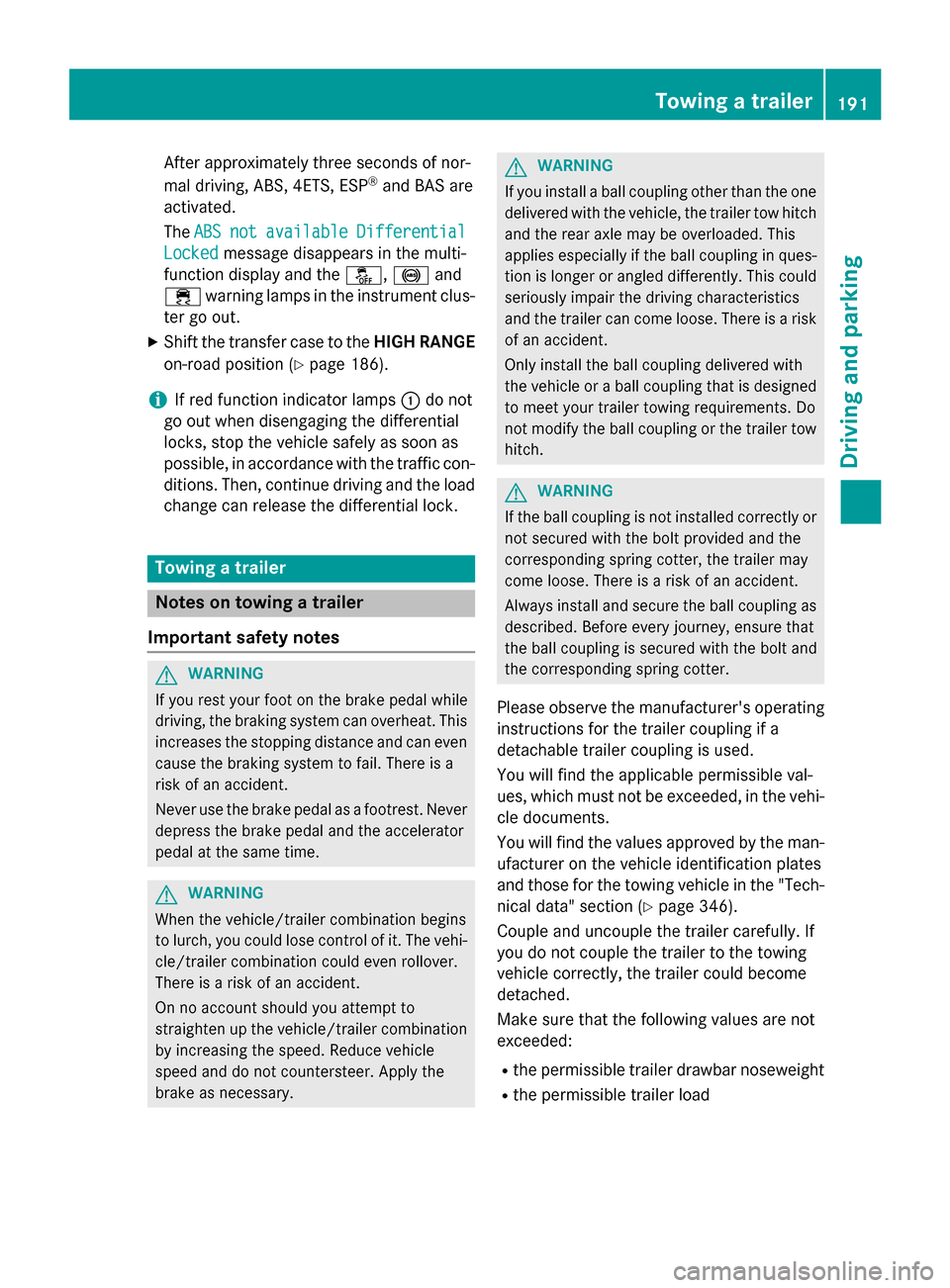
After approximately three seconds of nor-
mal driving, ABS, 4ETS, ESP ®
and BAS are
activated.
The ABS ABS not
not available
available Differential
Differential
Locked
Locked message disappears in the multi-
function display and the å,!and
÷ warning lamps in the instrument clus-
ter go out.
X Shift the transfer case to the HIGH RANGE
on-road position (Y page 186).
i If red function indicator lamps
:do not
go out when disengaging the differential
locks, stop the vehicle safely as soon as
possible, in accordance with the traffic con- ditions. Then, continue driving and the load
change can release the differential lock. Towing a trailer
Notes on towing a trailer
Important safety notes G
WARNING
If you rest your foot on the brake pedal while
driving, the braking system can overheat. This increases the stopping distance and can even
cause the braking system to fail. There is a
risk of an accident.
Never use the brake pedal as a footrest. Never
depress the brake pedal and the accelerator
pedal at the same time. G
WARNING
When the vehicle/trailer combination begins
to lurch, you could lose control of it. The vehi- cle/trailer combination could even rollover.
There is a risk of an accident.
On no account should you attempt to
straighten up the vehicle/trailer combination
by increasing the speed. Reduce vehicle
speed and do not countersteer. Apply the
brake as necessary. G
WARNING
If you install a ball coupling other than the one
delivered with the vehicle, the trailer tow hitch and the rear axle may be overloaded. This
applies especially if the ball coupling in ques-tion is longer or angled differently. This could seriously impair the driving characteristics
and the trailer can come loose. There is a risk
of an accident.
Only install the ball coupling delivered with
the vehicle or a ball coupling that is designed
to meet your trailer towing requirements. Do
not modify the ball coupling or the trailer tow hitch. G
WARNING
If the ball coupling is not installed correctly or not secured with the bolt provided and the
corresponding spring cotter, the trailer may
come loose. There is a risk of an accident.
Always install and secure the ball coupling as
described. Before every journey, ensure that
the ball coupling is secured with the bolt and
the corresponding spring cotter.
Please observe the manufacturer's operating instructions for the trailer coupling if a
detachable trailer coupling is used.
You will find the applicable permissible val-
ues, which must not be exceeded, in the vehi-
cle documents.
You will find the values approved by the man- ufacturer on the vehicle identification plates
and those for the towing vehicle in the "Tech-
nical data" section (Y page 346).
Couple and uncouple the trailer carefully. If
you do not couple the trailer to the towing
vehicle correctly, the trailer could become
detached.
Make sure that the following values are not
exceeded:
R the permissible trailer drawbar noseweight
R the permissible trailer load Towing a trailer
191Driving and parking Z
Page 196 of 350
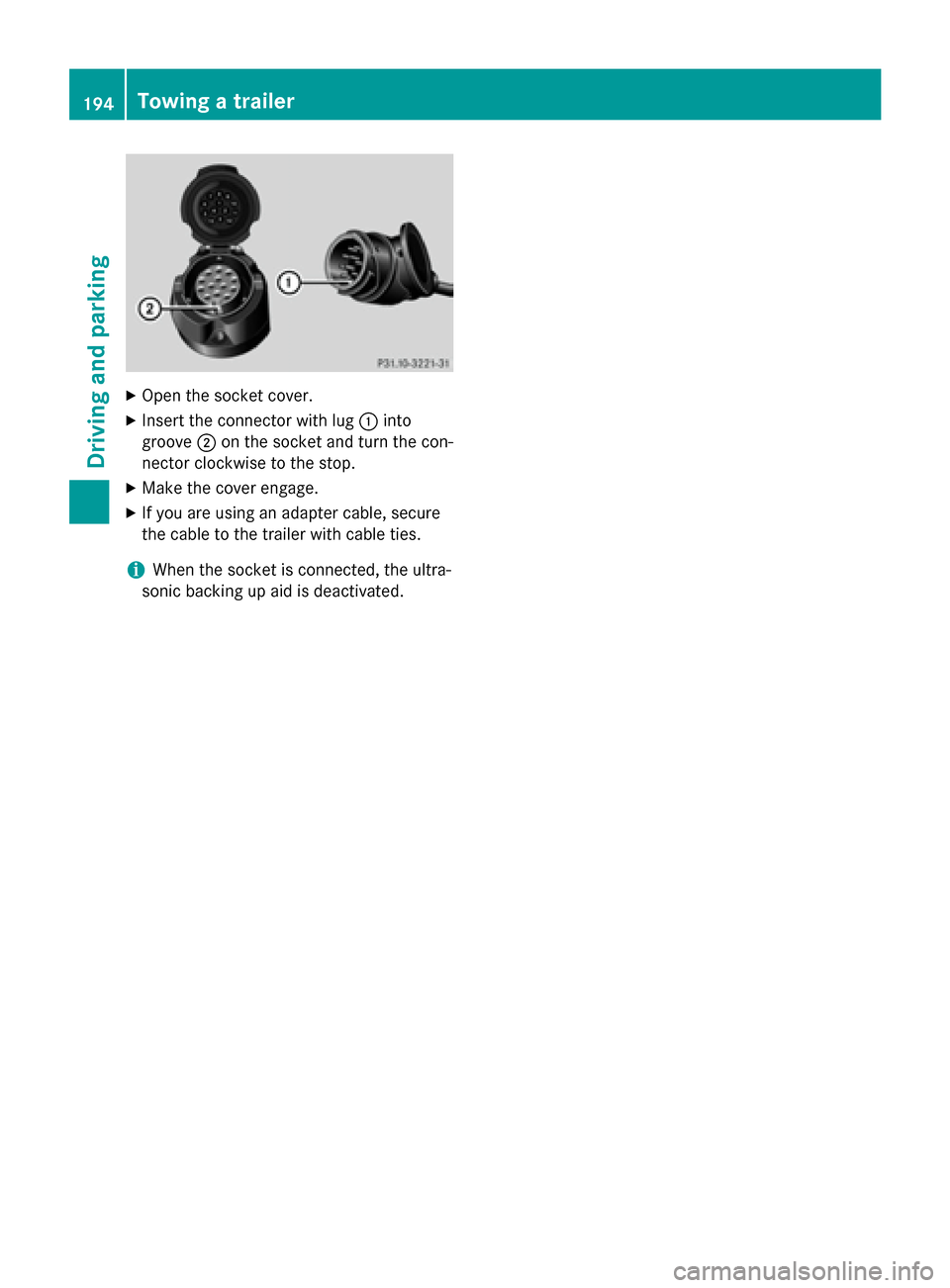
X
Open the socket cover.
X Insert the connector with lug :into
groove ;on the socket and turn the con-
nector clockwise to the stop.
X Make the cover engage.
X If you are using an adapter cable, secure
the cable to the trailer with cable ties.
i When the socket is connected, the ultra-
sonic backing up aid is deactivated. 194
Towing a trailerDriving and parking
Page 218 of 350

Display messages
Possible causes/consequences and
M
MSolutions $(USA
only)J
(Canada
only)
Check Brake Fluid Check Brake Fluid
Level Level There is not enough brake fluid in the brake fluid reservoir. In
addition, the
$(USA only)/J (Canada only) warning lamp
lights up in the instrument cluster and a warning tone sounds.
G WARNING
The braking effect may be impaired.
There is a risk of an accident.
X Pull over and stop the vehicle safely as soon as possible, paying
attention to road and traffic conditions. Do not continue driving
under any circumstances.
X Secure the vehicle against rolling away (Y page 150).
X Consult a qualified specialist workshop.
X Do not add brake fluid. This does not correct the malfunction. #
Check Brake Pad Check Brake Pad
Wear Wear The brake pads/linings have reached their wear limit.
X Visit a qualified specialist workshop. G
mbrace Inoperative mbrace Inoperative USA only:
one or more main functions of the mbrace system are
malfunctioning.
Canada only: one or more main functions of the TELE AID system
are malfunctioning.
X USA only: have the mbrace system checked at a qualified spe-
cialist workshop.
X Canada only: have the Tele AID system checked at a qualified
specialist workshop. 6
SRS Malfunction SRS Malfunction
Service Required Service Required The restraint system is faulty. The
6warning lamp also lights
up in the instrument cluster.
G WARNING
The air bags or Emergency Tensioning Devices may either be trig- gered unintentionally or, in the event of an accident, may not be
triggered.
There is an increased risk of injury.
X Visit a qualified specialist workshop.
For further information about the restraint system, see
(Y page 40). 216
Display
messagesOn-board computer and displays
Page 224 of 350
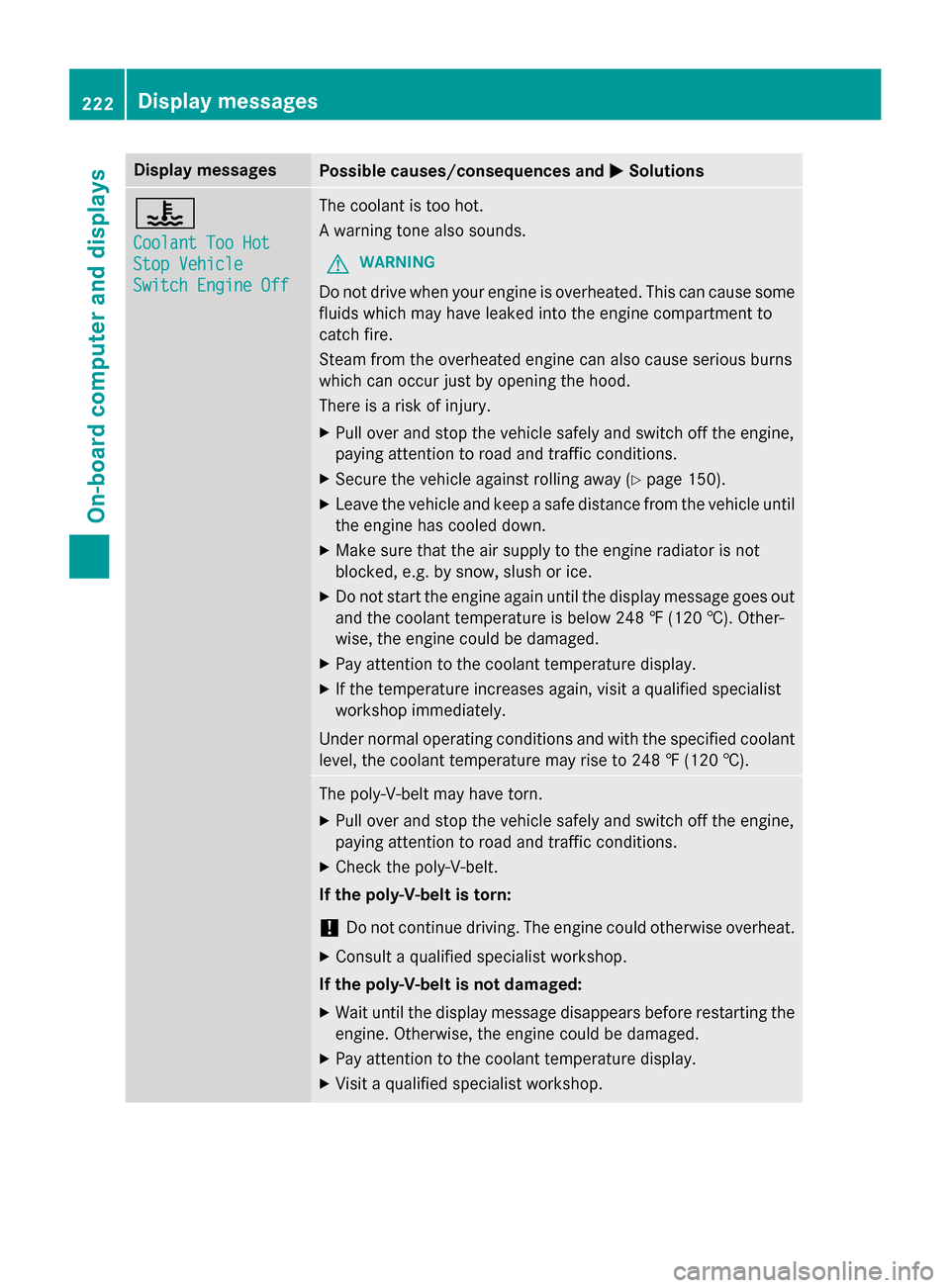
Display messages
Possible causes/consequences and
M
MSolutions ?
Coolant Too Hot Coolant Too Hot
Stop Vehicle Stop Vehicle
Switch Engine Off Switch Engine Off The coolant is too hot.
A warning tone also sounds.
G WARNING
Do not drive when your engine is overheated. This can cause some
fluids which may have leaked into the engine compartment to
catch fire.
Steam from the overheated engine can also cause serious burns
which can occur just by opening the hood.
There is a risk of injury.
X Pull over and stop the vehicle safely and switch off the engine,
paying attention to road and traffic conditions.
X Secure the vehicle against rolling away (Y page 150).
X Leave the vehicle and keep a safe distance from the vehicle until
the engine has cooled down.
X Make sure that the air supply to the engine radiator is not
blocked, e.g. by snow, slush or ice.
X Do not start the engine again until the display message goes out
and the coolant temperature is below 248 ‡ (120 †). Other-
wise, the engine could be damaged.
X Pay attention to the coolant temperature display.
X If the temperature increases again, visit a qualified specialist
workshop immediately.
Under normal operating conditions and with the specified coolant
level, the coolant temperature may rise to 248 ‡ (120 †). The poly-V-belt may have torn.
X Pull over and stop the vehicle safely and switch off the engine,
paying attention to road and traffic conditions.
X Check the poly-V-belt.
If the poly-V-belt is torn:
! Do not continue driving. The engine could otherwise overheat.
X Consult a qualified specialist workshop.
If the poly-V-belt is not damaged:
X Wait until the display message disappears before restarting the
engine. Otherwise, the engine could be damaged.
X Pay attention to the coolant temperature display.
X Visit a qualified specialist workshop. 222
Display
messagesOn-board computer and displays
Page 227 of 350

Driving systems
Display messages
Possible causes/consequences and
M
MSolutions TC shift condi‐
TC shift condi‐
tions tions
not
notfulfilled
fulfilled
Apply the brake/
Apply the brake/
parking brake parking brake The parking brake has not been applied and the brake pedal has
not been depressed. The transfer case has canceled the gear
change process and is in Neutral. There is no connection between
the engine and the drive wheels.
X Pull over and stop the vehicle safely as soon as possible, paying
attention to road and traffic conditions.
X Depress the brake pedal and apply the parking brake.
X Shift the automatic transmission to neutral position N.
X Make sure all conditions for changing gears are met
(Y page 186).
X Repeat the gearshift process. TC malfunction TC malfunction
Consult workshop Consult workshop
about about
applying
applying the
the
parking brake
parking brake There is a malfunction in the transfer case.
X Do not shift the transfer case.
X When parking, secure the vehicle against rolling away
(Y page 150).
X Have the vehicle checked at a qualified specialist workshop. TC shift canceled TC shift canceled
Reactivate Reactivate The transfer case has not performed the gear change process.
X Repeat the gearshift process.
X Make sure all conditions for changing gears are met
(Y page 186). TC shift condi‐ TC shift condi‐
tions tions
not
notfulfilled
fulfilled
Max. speed 25 mph
Max. speed 25 mph You have exceeded the maximum speed for the gearshift process.
X Drive more slowly.
X Repeat the gearshift process. TC shift condi‐
TC shift condi‐
tions tions
not
notfulfilled
fulfilled
Select
Select NEUTRAL
NEUTRAL gear
gear You have not met one or more shift conditions.
X Shift the automatic transmission to neutral position N.
X Repeat the gearshift process. TC shift condi‐
TC shift condi‐
tions tions
not
notfulfilled
fulfilled
Max. speed 40 mph
Max. speed 40 mph You have exceeded the maximum speed for the gearshift process.
X Drive more slowly.
X Repeat the gearshift process. LOW RANGE
LOW RANGE
ON ON The transfer case is in the
LOW RANGEoff-road position. HIGH RANGE
HIGH RANGE
ON ON The transfer case is in the
HIGH RANGEon-road position. Display
messages
225On-board computer and displays Z
Page 228 of 350
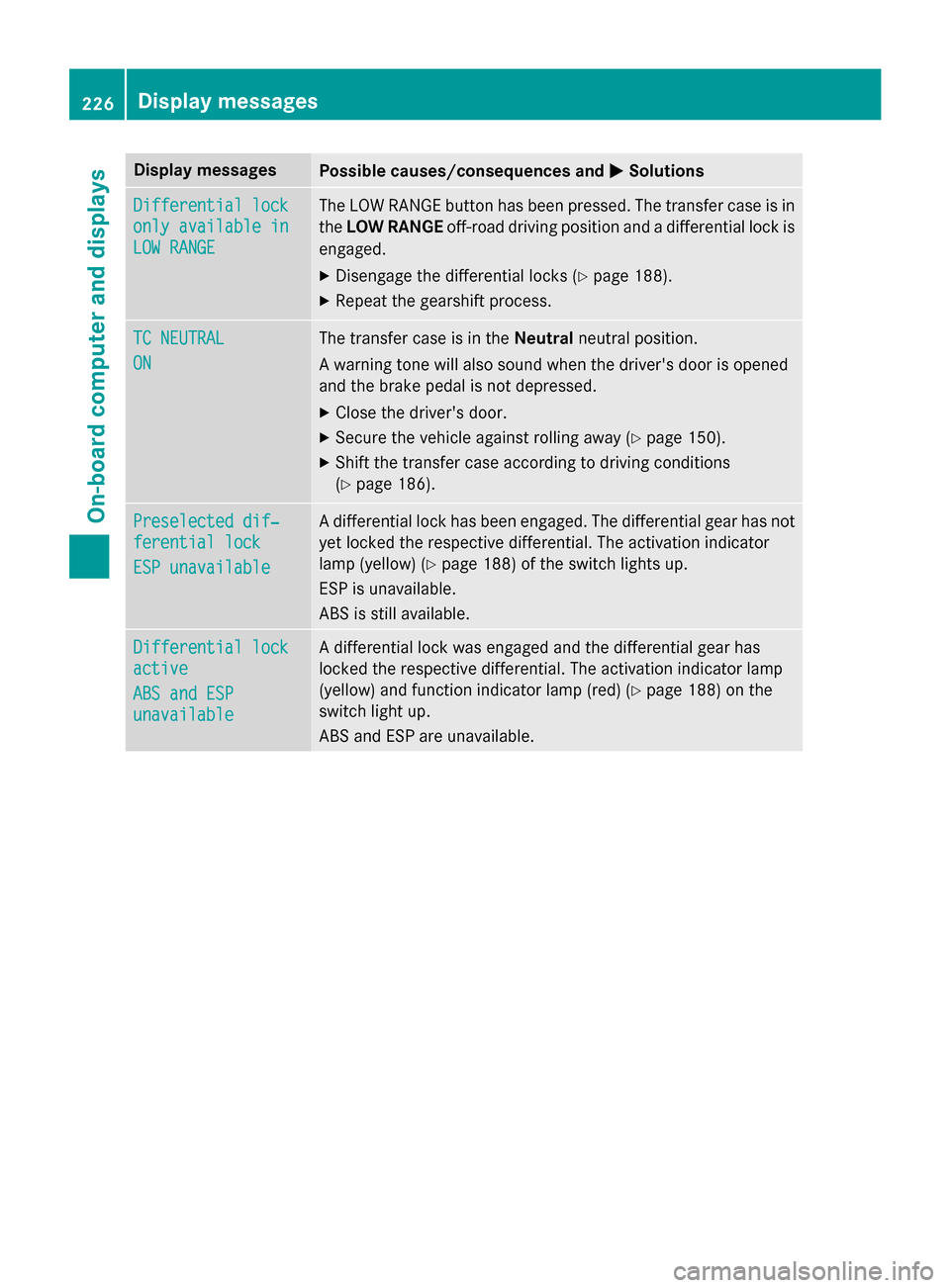
Display messages
Possible causes/consequences and
M
MSolutions Differential lock
Differential lock
only available in only available in
LOW RANGE LOW RANGE The LOW RANGE button has been pressed. The transfer case is in
the LOW RANGE off-road driving position and a differential lock is
engaged.
X Disengage the differential locks (Y page 188).
X Repeat the gearshift process. TC NEUTRAL
TC NEUTRAL
ON ON The transfer case is in the
Neutralneutral position.
A warning tone will also sound when the driver's door is opened
and the brake pedal is not depressed.
X Close the driver's door.
X Secure the vehicle against rolling away (Y page 150).
X Shift the transfer case according to driving conditions
(Y page 186). Preselected dif‐ Preselected dif‐
ferential lock ferential lock
ESP unavailable ESP unavailable A differential lock has been engaged. The differential gear has not
yet locked the respective differential. The activation indicator
lamp (yellow) (Y page 188) of the switch lights up.
ESP is unavailable.
ABS is still available. Differential lock Differential lock
active active
ABS and ESP ABS and ESP
unavailable unavailable A differential lock was engaged and the differential gear has
locked the respective differential. The activation indicator lamp
(yellow) and function indicator lamp (red) (Y page 188) on the
switch light up.
ABS and ESP are unavailable. 226
Display
messagesOn-board computer and displays
Page 232 of 350
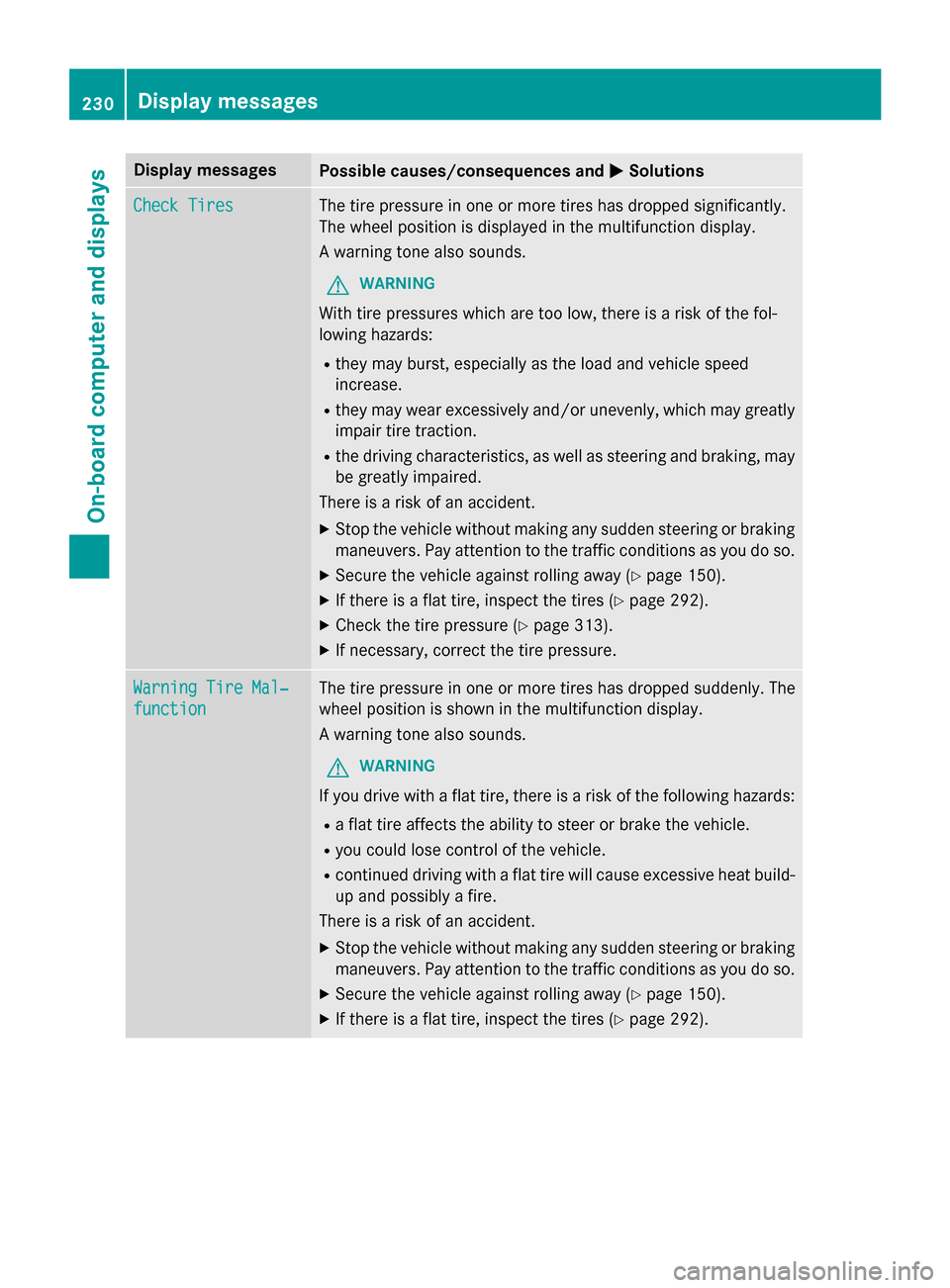
Display messages
Possible causes/consequences and
M
MSolutions Check Tires
Check Tires The tire pressure in one or more tires has dropped significantly.
The wheel position is displayed in the multifunction display.
A warning tone also sounds.
G WARNING
With tire pressures which are too low, there is a risk of the fol-
lowing hazards:
R they may burst, especially as the load and vehicle speed
increase.
R they may wear excessively and/or unevenly, which may greatly
impair tire traction.
R the driving characteristics, as well as steering and braking, may
be greatly impaired.
There is a risk of an accident.
X Stop the vehicle without making any sudden steering or braking
maneuvers. Pay attention to the traffic conditions as you do so.
X Secure the vehicle against rolling away (Y page 150).
X If there is a flat tire, inspect the tires (Y page 292).
X Check the tire pressure (Y page 313).
X If necessary, correct the tire pressure. Warning Tire Mal‐ Warning Tire Mal‐
function function The tire pressure in one or more tires has dropped suddenly. The
wheel position is shown in the multifunction display.
A warning tone also sounds.
G WARNING
If you drive with a flat tire, there is a risk of the following hazards: R a flat tire affects the ability to steer or brake the vehicle.
R you could lose control of the vehicle.
R continued driving with a flat tire will cause excessive heat build-
up and possibly a fire.
There is a risk of an accident.
X Stop the vehicle without making any sudden steering or braking
maneuvers. Pay attention to the traffic conditions as you do so.
X Secure the vehicle against rolling away (Y page 150).
X If there is a flat tire, inspect the tires (Y page 292).230
Display
messagesOn-board computer and displays
Page 233 of 350
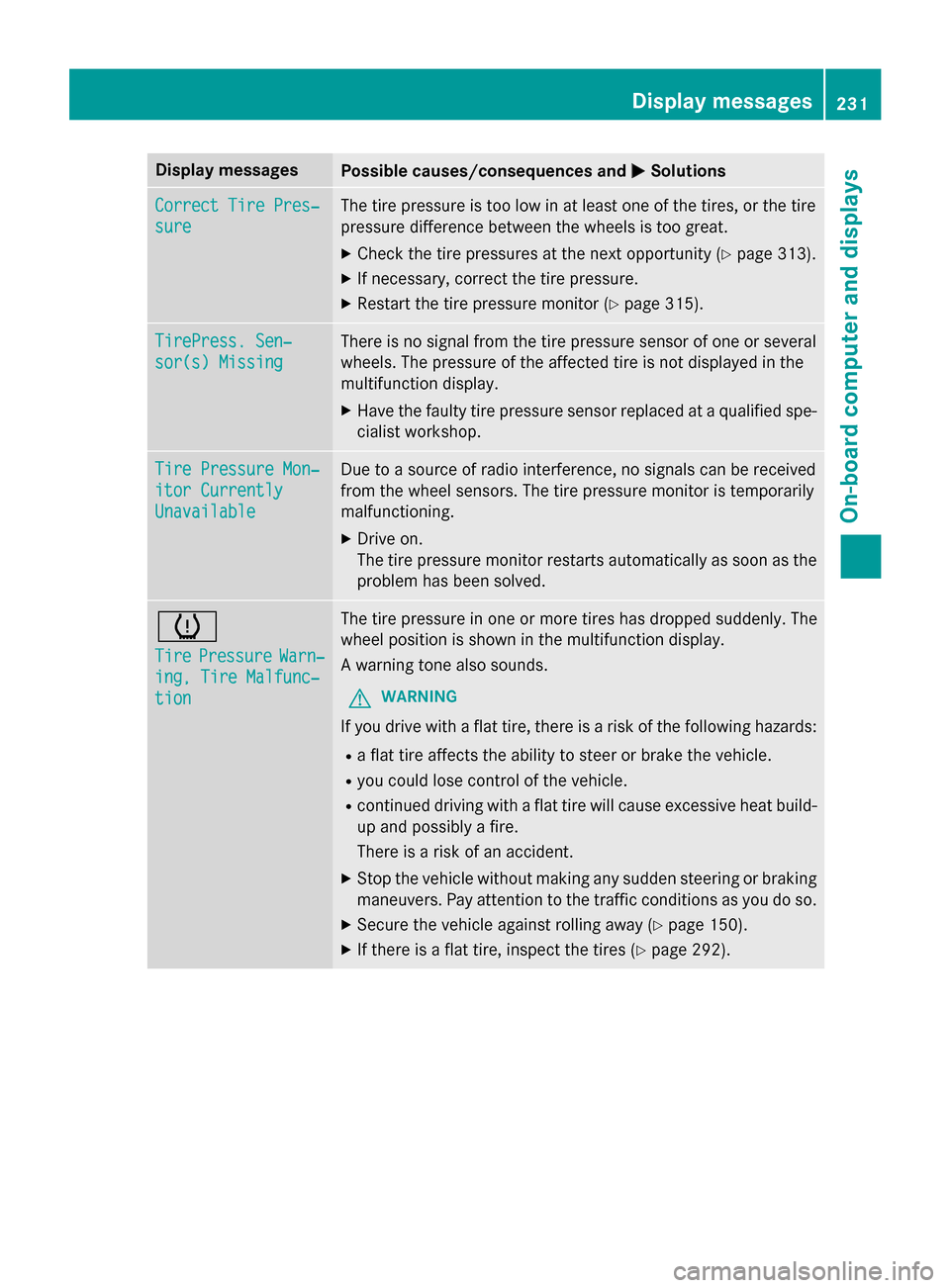
Display messages
Possible causes/consequences and
M
MSolutions Correct Tire Pres‐
Correct Tire Pres‐
sure sure The tire pressure is too low in at least one of the tires, or the tire
pressure difference between the wheels is too great.
X Check the tire pressures at the next opportunity (Y page 313).
X If necessary, correct the tire pressure.
X Restart the tire pressure monitor (Y page 315).TirePress. Sen‐
TirePress. Sen‐
sor(s) Missing sor(s) Missing There is no signal from the tire pressure sensor of one or several
wheels. The pressure of the affected tire is not displayed in the
multifunction display.
X Have the faulty tire pressure sensor replaced at a qualified spe-
cialist workshop. Tire Pressure Mon‐ Tire Pressure Mon‐
itor Currently itor Currently
Unavailable Unavailable Due to a source of radio interference, no signals can be received
from the wheel sensors. The tire pressure monitor is temporarily
malfunctioning.
X Drive on.
The tire pressure monitor restarts automatically as soon as the
problem has been solved. h
Tire Tire
Pressure
Pressure Warn‐
Warn‐
ing, Tire Malfunc‐
ing, Tire Malfunc‐
tion tion The tire pressure in one or more tires has dropped suddenly. The
wheel position is shown in the multifunction display.
A warning tone also sounds.
G WARNING
If you drive with a flat tire, there is a risk of the following hazards: R a flat tire affects the ability to steer or brake the vehicle.
R you could lose control of the vehicle.
R continued driving with a flat tire will cause excessive heat build-
up and possibly a fire.
There is a risk of an accident.
X Stop the vehicle without making any sudden steering or braking
maneuvers. Pay attention to the traffic conditions as you do so.
X Secure the vehicle against rolling away (Y page 150).
X If there is a flat tire, inspect the tires (Y page 292). Display
messages
231On-board computer and displays Z
Page 234 of 350
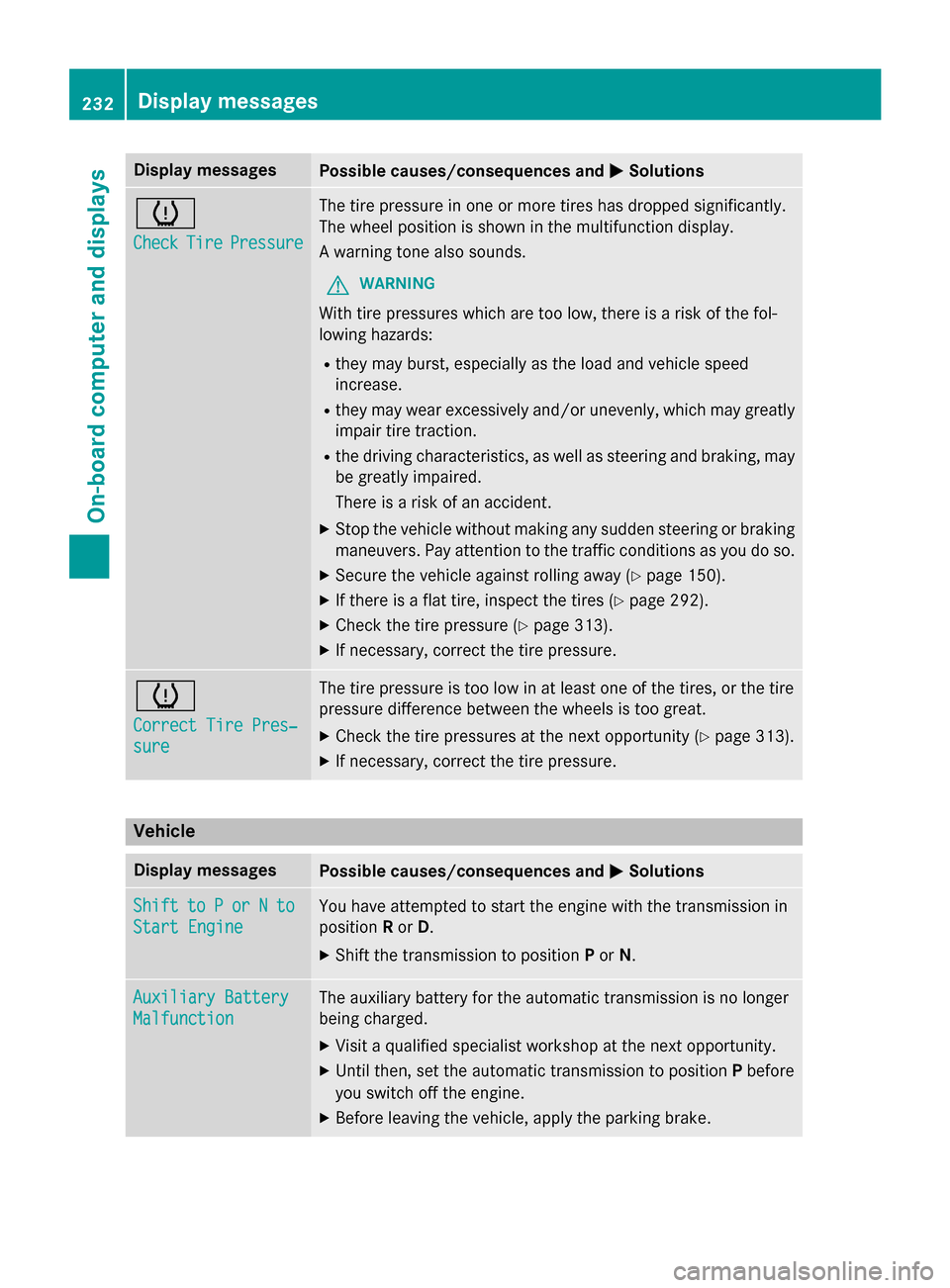
Display messages
Possible causes/consequences and
M
MSolutions h
Check Check
Tire
TirePressure
Pressure The tire pressure in one or more tires has dropped significantly.
The wheel position is shown in the multifunction display.
A warning tone also sounds.
G WARNING
With tire pressures which are too low, there is a risk of the fol-
lowing hazards:
R they may burst, especially as the load and vehicle speed
increase.
R they may wear excessively and/or unevenly, which may greatly
impair tire traction.
R the driving characteristics, as well as steering and braking, may
be greatly impaired.
There is a risk of an accident.
X Stop the vehicle without making any sudden steering or braking
maneuvers. Pay attention to the traffic conditions as you do so.
X Secure the vehicle against rolling away (Y page 150).
X If there is a flat tire, inspect the tires (Y page 292).
X Check the tire pressure (Y page 313).
X If necessary, correct the tire pressure. h
Correct Tire Pres‐ Correct Tire Pres‐
sure sure The tire pressure is too low in at least one of the tires, or the tire
pressure difference between the wheels is too great.
X Check the tire pressures at the next opportunity (Y page 313).
X If necessary, correct the tire pressure. Vehicle
Display messages
Possible causes/consequences and
M
MSolutions Shift
Shift
to
toP
Por
or N
Nto
to
Start Engine
Start Engine You have attempted to start the engine with the transmission in
position
Ror D.
X Shift the transmission to position Por N. Auxiliary Battery Auxiliary Battery
Malfunction Malfunction The auxiliary battery for the automatic transmission is no longer
being charged.
X Visit a qualified specialist workshop at the next opportunity.
X Until then, set the automatic transmission to position Pbefore
you switch off the engine.
X Before leaving the vehicle, apply the parking brake. 232
Display
messagesOn-board computer and displays
Page 235 of 350
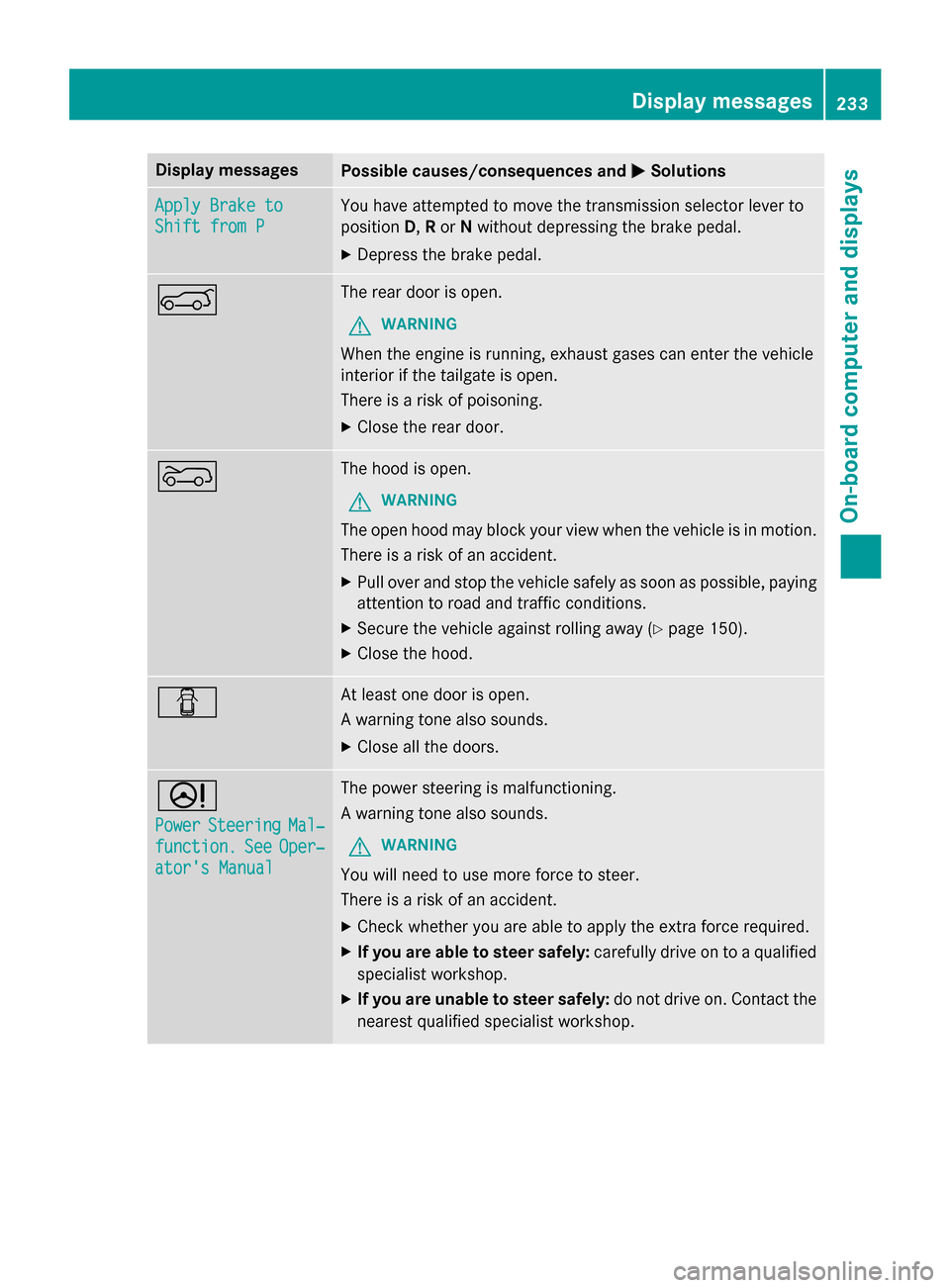
Display messages
Possible causes/consequences and
M
MSolutions Apply Brake to
Apply Brake to
Shift from P Shift from P You have attempted to move the transmission selector lever to
position
D,Ror Nwithout depressing the brake pedal.
X Depress the brake pedal. A The rear door is open.
G WARNING
When the engine is running, exhaust gases can enter the vehicle
interior if the tailgate is open.
There is a risk of poisoning.
X Close the rear door. ? The hood is open.
G WARNING
The open hood may block your view when the vehicle is in motion.
There is a risk of an accident.
X Pull over and stop the vehicle safely as soon as possible, paying
attention to road and traffic conditions.
X Secure the vehicle against rolling away (Y page 150).
X Close the hood. C At least one door is open.
A warning tone also sounds.
X Close all the doors. D
Power Power
Steering
Steering Mal‐
Mal‐
function.
function. See
SeeOper‐
Oper‐
ator's Manual
ator's Manual The power steering is malfunctioning.
A warning tone also sounds.
G WARNING
You will need to use more force to steer.
There is a risk of an accident. X Check whether you are able to apply the extra force required.
X If you are able to steer safely: carefully drive on to a qualified
specialist workshop.
X If you are unable to steer safely: do not drive on. Contact the
nearest qualified specialist workshop. Display
messages
233On-board computer and displays Z